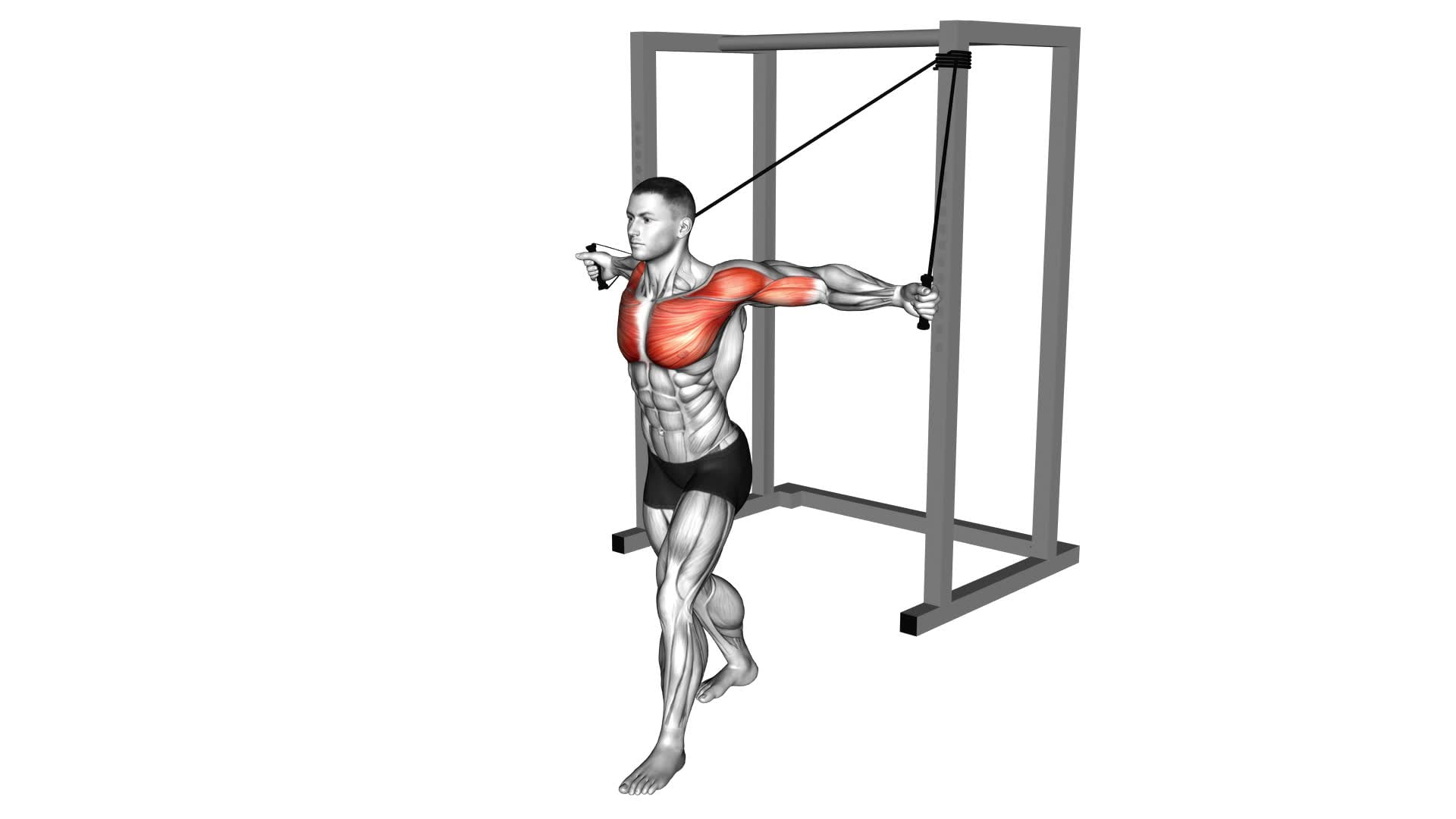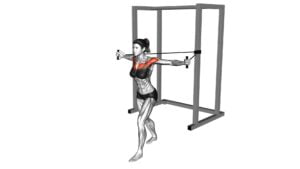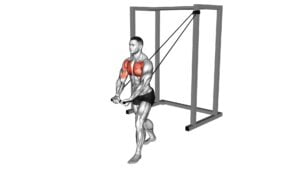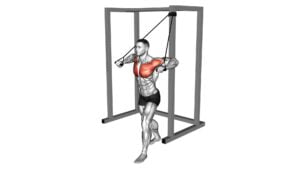Band Alternate Low Chest Fly (male) – Video Exercise Guide & Tips

Looking to target your chest muscles? Try the Band Alternate Low Chest Fly! This exercise, demonstrated in a video guide, is a great way to challenge and strengthen your chest.
Watch This Exercise Video
All you need is a resistance band. Watch the video and learn the proper form and technique to maximize your gains.
Avoid common mistakes and get tips on how to incorporate this exercise into your workout routine.
Get ready to pump up your chest!
Key Takeaways
- The Band Alternate Low Chest Fly is a beneficial exercise that targets and strengthens the chest muscles, specifically the pectoralis major and pectoralis minor.
- Proper form and technique are important for maximizing the effectiveness of the exercise, including maintaining correct body alignment, controlling movement speed, and focusing on tension in the chest muscles.
- Common mistakes to avoid include using too much weight, lifting the shoulders off the ground, rushing through the movement, and neglecting proper form.
- Tips for incorporating the Band Alternate Low Chest Fly into a workout routine include gradually increasing resistance, modifying the exercise on a stability ball to engage core muscles, and choosing an appropriate resistance band.
Benefits of the Band Alternate Low Chest Fly
The Band Alternate Low Chest Fly provides an effective way to target and strengthen your chest muscles. One of the main benefits of this exercise is that it helps to isolate and engage the chest muscles, specifically the pectoralis major and pectoralis minor. By using resistance bands, you can increase the tension on your muscles, leading to greater muscle activation and development. This exercise also allows for a greater range of motion compared to traditional chest exercises, which can help to improve flexibility and mobility in your chest muscles.
Additionally, the Band Alternate Low Chest Fly offers variations that can be tailored to your fitness level and goals. You can adjust the resistance of the bands by choosing different tension levels or by using multiple bands for added resistance. Furthermore, you can also modify the angle of the exercise by adjusting the height of the bands, allowing you to target different areas of your chest.
In order to properly perform the Band Alternate Low Chest Fly, it's important to maintain proper form and technique. Transitioning into the subsequent section, make sure to focus on maintaining a slight bend in your elbows throughout the exercise and avoid locking them out. This will help to keep the tension on your chest muscles and prevent strain or injury.
Proper Form and Technique for the Exercise
To perform the Band Alternate Low Chest Fly exercise with proper form and technique, it's important to focus on three key points:
- Maintaining correct body alignment: Keep your back straight, shoulders relaxed, and engage your core throughout the exercise to maintain proper body alignment.
- Controlling your movement speed: Control the movement by slowly and deliberately bringing the bands across your body, avoiding any jerking or swinging motions.
- Utilizing proper breathing technique: Remember to inhale during the eccentric phase and exhale during the concentric phase to maintain proper breathing technique and maximize your results.
Correct Body Alignment
Maintain proper body alignment during the Band Alternate Low Chest Fly exercise by focusing on your form and technique. Here are four important tips to ensure correct body alignment:
- Stand tall with your feet shoulder-width apart and your core engaged. This will help stabilize your body and maintain balance throughout the exercise.
- Keep your shoulders relaxed and away from your ears. Avoid shrugging or tensing them, as this can lead to unnecessary strain on your neck and upper back.
- Maintain a slight bend in your elbows throughout the movement. This will help target the chest muscles and prevent excessive stress on the joints.
- Focus on keeping your chest lifted and your spine neutral. Avoid rounding your shoulders or arching your back, as this can compromise your form and lead to potential injuries.
Controlled Movement Speed
Stand tall, engage your core, and focus on maintaining controlled movement speed throughout the Band Alternate Low Chest Fly exercise. Controlled movement is essential for proper form and technique, as it helps target the muscles effectively and prevents injury. By controlling the speed of your movements, you can increase the exercise intensity and challenge your chest muscles even more.
Avoid rushing through the exercise and instead, focus on the quality of your movements. Keep a steady pace, ensuring that you're in control of the resistance band throughout the entire range of motion. Remember, the key is to maintain control and avoid any jerky or erratic movements.
This won't only maximize the benefits of the exercise but also enhance your overall strength and stability.
Proper Breathing Technique
Breathe rhythmically and deeply during the Band Alternate Low Chest Fly exercise to enhance your form and technique. Proper breathing techniques play a crucial role in muscle activation and overall exercise performance. Here are four key points to keep in mind:
- Inhale during the eccentric phase: As you lower the bands towards your sides, take a deep breath in. This helps stabilize your torso and prepares your muscles for the upcoming contraction.
- Exhale during the concentric phase: As you bring the bands back to the starting position, exhale forcefully. This generates more power and helps engage your chest muscles effectively.
- Avoid breath holding: Holding your breath can lead to increased tension in your body and limit your range of motion. Remember to breathe continuously throughout the exercise.
- Maintain a steady rhythm: Coordinate your breathing with the movement, ensuring a smooth and controlled flow. This promotes better oxygenation and improves your overall performance.
Equipment Needed for the Band Alternate Low Chest Fly
To perform the Band Alternate Low Chest Fly exercise, you'll need the following equipment: resistance bands.
Resistance bands are flexible bands made of rubber or latex that provide resistance when stretched. They're an excellent tool for targeting and activating the muscles in your chest.
Resistance bands are particularly effective for chest workouts because they allow for a wider range of motion compared to traditional weightlifting exercises. They also provide constant tension throughout the movement, which helps to engage and activate your chest muscles more effectively.
When choosing resistance bands for the Band Alternate Low Chest Fly, it's important to select a band with the appropriate level of resistance. The band should offer enough resistance to challenge your muscles, but not so much that it compromises your form or causes discomfort. It's recommended to start with a lighter resistance band and gradually increase the resistance as you become stronger and more comfortable with the exercise.
In addition to resistance bands, you may also need a sturdy anchor point to secure the bands during the exercise. This can be a door frame, a sturdy piece of furniture, or a wall-mounted anchor specifically designed for resistance bands.
Variations and Modifications to Challenge Your Chest Muscles
To further challenge your chest muscles, you can explore different variations and modifications of the Band Alternate Low Chest Fly exercise. Here are four variations and modifications that you can try:
- Increase the resistance:
Use a stronger resistance band or add more tension to the band you're currently using. This will make the exercise more challenging and help you build more strength in your chest muscles.
- Change the angle:
Instead of performing the exercise with your arms straight out in front of you, try doing it with your arms at a slightly different angle. For example, you can bring your arms slightly higher or lower, or even perform the exercise with your arms slightly out to the sides. This variation will target different areas of your chest muscles.
- Use different grips:
Instead of holding the resistance band with your palms facing down, try using different grips. You can try an underhand grip, where your palms are facing up, or an overhand grip, where your palms are facing down. This will engage different muscles in your chest and provide a new challenge.
- Combine with other exercises:
To make the Band Alternate Low Chest Fly even more challenging, you can combine it with other chest exercises. For example, you can perform a set of push-ups immediately after a set of Band Alternate Low Chest Fly. This will provide a more intense workout for your chest muscles.
Common Mistakes to Avoid While Performing the Exercise
To maximize the effectiveness of the Band Alternate Low Chest Fly exercise and avoid common mistakes, follow these tips for improvement.
- One common mistake to watch out for is using too much weight. It's important to choose a resistance band that allows you to perform the exercise with proper form and control. Using excessive weight can lead to poor technique and increase the risk of injury.
- Another mistake to avoid is lifting the shoulders off the ground. Keep your shoulder blades pressed down and maintain a stable position throughout the movement. This will ensure that the focus stays on the chest muscles and prevents unnecessary strain on the shoulders.
- Additionally, make sure to maintain a slow and controlled tempo throughout the exercise. Avoid rushing through the movement or using momentum to lift the bands. This will help maximize the engagement of the chest muscles and promote muscle growth.
Tips for Incorporating the Band Alternate Low Chest Fly Into Your Workout Routine
To get the most out of your workout routine, it's important to incorporate the Band Alternate Low Chest Fly exercise properly.
First, focus on maintaining proper form throughout the movement by keeping your back straight, core engaged, and chest lifted.
For beginners, variations such as using lighter resistance bands or starting with fewer repetitions can help build strength and prevent injury.
Proper Form Tips
When incorporating the Band Alternate Low Chest Fly into your workout routine, it's important to maintain proper form. Here are some tips to help you do it correctly:
- Keep your back straight: Avoid arching or rounding your back during the exercise. Engage your core to maintain a stable and neutral spine.
- Control the movement: Slowly bring your arms out to the sides while maintaining a slight bend in your elbows. Avoid any jerking or swinging motions.
- Squeeze your chest muscles: As you bring your arms together, focus on squeezing your chest muscles. This will maximize the effectiveness of the exercise.
- Use appropriate resistance: Choose a band with the right amount of resistance for your fitness level. It should challenge you without compromising your form.
By following these proper form tips, you can ensure that you get the most out of your Band Alternate Low Chest Fly.
Now, let's move on to discussing variations for beginners.
Variations for Beginners
To incorporate the Band Alternate Low Chest Fly into your workout routine as a beginner, try these variations for added challenge and effectiveness. If you find the exercise too difficult initially, you can modify it by using lighter resistance bands or adjusting the tension. As you build strength, you can gradually increase the resistance.
Another modification option is to perform the exercise while lying on a stability ball instead of a bench, which will engage your core muscles as well. To progress further, you can increase the number of reps or sets, or even try using heavier resistance bands. These variations will help you gradually improve your chest strength and overall fitness level.
Now, let's move on to discuss the benefits of this exercise.
Benefits of This Exercise
To maximize the benefits of incorporating the Band Alternate Low Chest Fly into your workout routine, focus on maintaining proper form and gradually increasing the resistance for a challenging and effective chest workout. Here are four key benefits of this exercise and tips for incorporating it into your routine:
- Improved chest muscle activation: The Band Alternate Low Chest Fly targets the pectoralis major and minor muscles, helping to strengthen and tone your chest.
- Increased stability and balance: By using resistance bands instead of weights, this exercise engages your stabilizing muscles, enhancing overall balance and stability.
- Versatility and convenience: The band variation allows for a wide range of motion and can be done anywhere, making it a versatile and convenient option for your workout routine.
- Injury prevention: As a low-impact exercise, the Band Alternate Low Chest Fly can help reduce the risk of injury while still providing an effective chest workout.
Incorporate this exercise into your routine to enjoy these benefits and add variation to your chest workouts.
Frequently Asked Questions
How Many Sets and Repetitions Should I Do for the Band Alternate Low Chest Fly?
To progress with the band alternate low chest fly, start with 2-3 sets of 12-15 repetitions. As you get stronger, gradually increase the number of sets and repetitions.
This exercise targets your chest muscles and helps improve upper body strength. It also activates your stabilizer muscles for better balance and coordination.
Can I Perform the Band Alternate Low Chest Fly Without Using a Resistance Band?
Yes, you can perform the band alternate low chest fly without using a resistance band.
However, using a resistance band has several benefits for improving chest muscle strength.
Resistance bands provide constant tension throughout the exercise, which can lead to greater muscle activation and growth.
They also allow for a wider range of motion and help to stabilize the muscles surrounding the chest.
What Are Some Alternative Exercises That Target the Same Muscles as the Band Alternate Low Chest Fly?
If you're looking for alternative exercises that target the same muscles as the band alternate low chest fly, there are a few options you can try.
One option is the dumbbell chest fly, which works the same muscles but uses dumbbells instead of a resistance band.
Another variation is the push-up, which also engages the chest muscles.
These exercises can provide a similar workout to the band alternate low chest fly without the need for a resistance band.
Is the Band Alternate Low Chest Fly Suitable for Beginners?
The band alternate low chest fly is a great exercise for beginners. It helps in developing chest muscles and provides several benefits.
To modify the exercise for beginners, you can start with lighter resistance bands and gradually increase the intensity. It's important to maintain proper form and control throughout the movement.
This exercise is suitable for beginners who are looking to strengthen and tone their chest muscles.
Can the Band Alternate Low Chest Fly Help With Improving Posture?
Incorporating resistance bands into your workout routine has numerous benefits. The band alternate low chest fly can help improve your posture. To perform this exercise effectively, start by securing the bands at chest height and standing with your feet shoulder-width apart. Hold the handles with your palms facing down and extend your arms out to the sides, squeezing your chest muscles. Alternate the movement of your arms while maintaining a controlled motion. This exercise targets the chest and helps develop a strong, upright posture.
Conclusion
Incorporating the band alternate low chest fly into your workout routine is a great way to challenge and strengthen your chest muscles.
By using proper form and technique, along with variations and modifications, you can maximize the benefits of this exercise.
Remember to avoid common mistakes and use the necessary equipment for optimal results.
Add this exercise to your routine to enhance your chest workout.

Author
Years ago, the spark of my life’s passion ignited in my mind the moment I stepped into the local gym for the first time. The inaugural bead of perspiration, the initial endeavor, the very first surge of endorphins, and a sense of pride that washed over me post-workout marked the beginning of my deep-seated interest in strength sports, fitness, and sports nutrition. This very curiosity blossomed rapidly into a profound fascination, propelling me to earn a Master’s degree in Physical Education from the Academy of Physical Education in Krakow, followed by a Sports Manager diploma from the Jagiellonian University. My journey of growth led me to gain more specialized qualifications, such as being a certified personal trainer with a focus on sports dietetics, a lifeguard, and an instructor for wellness and corrective gymnastics. Theoretical knowledge paired seamlessly with practical experience, reinforcing my belief that the transformation of individuals under my guidance was also a reflection of my personal growth. This belief holds true even today. Each day, I strive to push the boundaries and explore new realms. These realms gently elevate me to greater heights. The unique combination of passion for my field and the continuous quest for growth fuels my drive to break new ground.







